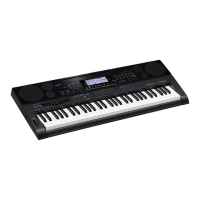E-44
Using the Tone Editor
You can create a user tone by editing one of the built-in preset
tones.
• This section covers editing of preset tone groups A through
J.
• For information about editing group L (drawbar organ)
tones, see “Editing Drawbar Organ Tones” (page E-52).
The preset tones built into this Digital Keyboard consist of a
number of parameters. To create a user tone, you first recall a
preset tone (A:001 to J:128) and then modify its parameters to
change it to your own original tone.
Note that drum set sounds (J:129 to J:146) cannot be used as
the basis of a user tone.
The illustration nearby shows the parameters that make up
the preset tones, and what each parameter does. As can be
seen in the illustration, parameters can be divided into four
groups, each of which is described in detail below.
C-17C-17
R-15R-15
R-16R-16R-14R-14
C-8C-8 R-13R-13
R-17R-17
Tone Creation Overview
Volume Characteristic
Parameters
•Attack Time
• Release Time
• Cutoff Frequency
Tone Pitch Parameters
• Vibrato Type
• Vibrato Depth
• Vibrato Rate
• Vibrato Delay
• Octave Shift
Tone Characteristic
Setting Parameters
• Volume
• Touch Sense
• Reverb Send
• Chorus Send
• DSP Line
• DSP Type
• DSP Parameters
Tone
Characteristic
Waveform
• Tone
Setting
Output
CTK7000_e.book 44 ページ 2010年7月21日 水曜日 午後5時15分

